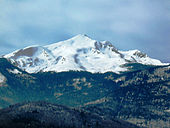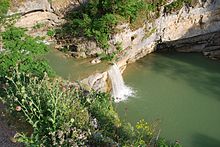Kosovo
![]()
The title of this article is ambiguous. For other meanings, see Kosovo (disambiguation).
Kosovo (also Kosovo or Kosovo, Albanian Kosova/Kosovë, Serbian Cyrillic Косово), officially the Republic of Kosovo, is a republic in southeastern Europe on the western part of the Balkan Peninsula. The Republic of Kosovo has about 1.9 million inhabitants (called Kosovars) and is considered a stabilized de facto regime. The capital and largest city is Pristina.
Kosovo was formerly part of the Socialist Federal Republic of Yugoslavia, from 26 April 1992 part of the newly constituted federal Federal Republic of Yugoslavia and from 2003 a sub-region of the Republic of Serbia. Recent history has been marked by the Kosovo War of 1999 and its aftermath. The country's current status under international law is disputed. On 17 February 2008, the parliament proclaimed the territory's independence. 115 of the 193 member states of the United Nations recognize the Republic of Kosovo as an independent state.
While formally remaining part of the Federal Republic of Yugoslavia, Kosovo was placed under the administrative jurisdiction of the United Nations after the war in 1999. The international legal basis for this was UN Security Council Resolution 1244, which guarantees the sovereignty and territorial integrity of the Federal Republic of Yugoslavia, whose legal successor is today's Serbia. In addition, political developments have been monitored by EULEX Kosovo since 9 December 2008. This also applies to the predominantly Serb-inhabited region of northern Kosovo, which is currently only partially controlled by the Kosovo government.
On 22 July 2010, the International Court of Justice (ICJ), in a legally non-binding advisory opinion requested by the UN General Assembly at Serbia's initiative, concluded that Kosovo's declaration of independence did not violate international law. At the same time, the ICJ avoided assessing Kosovo's status under international law and recognized the validity of UN Resolution 1244.
The Serbian government formally considers Kosovo as its Autonomous Province of Kosovo and Metohija (Serbian Аутономна покрајина Косово и Метохија Autonomna pokrajina Kosovo i Metohija, abbreviated Космет/Kosmet; Albanian Krahina Autonome e Kosovës dhe Metohisë), however, acknowledges that "Serbian sovereignty over Kosovo is practically non-existent" and that Serbia's "true borders" remain to be determined in the future.
The country has been a member of the International Monetary Fund (IMF) and the World Bank Group since June 2009. It has also been a member of the European Bank for Reconstruction and Development since November 2012.
Names and etymology
Kosovo usually refers to the entire territory. Kosovo is also used in Serbo-Croatian with the same meaning. In addition, nationally conscious Serbs use the term Kosmet, a word combination of Kosovo and Metohija, in parallel.
Kos in Serbo-Croatian refers to the blackbird. The region is named after the Blackbird Field (Serbian Kosovo Polje, Albanian Fushë Kosovë) near Pristina. The word kosovo is a possessive adjective ("belonging to the blackbird") and therefore actually incomplete without an additional polje ("field"). However, the abbreviation has become common in this form.
The name Metohija for western Kosovo is derived from the Greek μετοχή (metochí "monastic estate"). This name, which describes a landscape characterized by many churches and monasteries, was no longer used by the state in Yugoslavia after 1974. The Kosovo Albanians call this region Dukagjini or Rrafshi i Dukagjinit.
Dardania is a common historical name for Kosovo among Albanians. It derives from the ancient Illyrian people of the Dardans, who lived in the area of present-day Kosovo. It included the present territory of Kosovo, as well as some areas in southern Serbia and northern Macedonia. In October 2000, the future President Ibrahim Rugova presented his proposal for a future flag of Kosovo. On it was a banner with the name "Dardania", which Rugova proposed as the country name of an independent Kosovo.
Geography
→ Main article: Geography of Kosovo
Kosovo is landlocked in the centre of the Balkan Peninsula. It borders Albania to the southwest, Montenegro to the northwest, Serbia and central Serbia to the north and east, and northern Macedonia to the southeast. Tectonically, the levelled areas of the Blackbird Field and Metohija are entirely bordered by mountains. The mountain ranges of the Prokletije border Kosovo with Montenegro and Albania, the Kopaonik with Serbia and the Šar Planina with northern Macedonia.
With 10,877 km², Kosovo, the smallest country in Southeast Europe, has about two thirds of the area of Thuringia and is comparatively densely populated with 195 inhabitants per square kilometre. 53 % of the area is used for agriculture, 42 % is forest and 5 % is built-up or urban area.
Due to the spatial structure of a depression surrounded by high mountains, Kosovo has always been an important agricultural region - the Amselfeld wine is well known - as well as the centre of the Balkan long-distance grazing economy, in which the lowlands of Metohija in particular were used as winter grazing areas and were still visited by Thessalian and North Serbian migrant shepherds in the 19th century. A special feature of livestock farming is the use of water buffaloes, which in some cases continues to this day.
In terms of settlement geography, the higher-lying Blackbird Field with its capital Pristina, which stretches between the Ibar and the Southern Morava as a long depression, is today the economically more important region. Historically, Metohija was more important, with the oldest urban centres of Prizren, the ancient Roman administrative centre and later Serbian imperial city, and Peja. The plains are separated from each other by hilly low mountainous terrain, largely covered by sparse oak forests, which makes communication routes difficult.
The high mountain landscapes on the borders with Albania, Montenegro and northern Macedonia reach 2500 m throughout. The highest mountains are Rudoka (in Šar Planina, 2658 m), Gjeravica (in the municipality of Peja, 2656 m), Bistra (municipality of Ferizaj, 2640 m), Marjash (Peja, 2530 m), Ljuboten (alb. Luboten, Ferizaj, 2496 m) and Koproniku (Peja, 2460 m). Largely built up of silicate rocks, the mountains are usually also rich in water and well suited for cattle herding. Karst mountains such as Koproniku and the central parts of Šar Planina with Bistra are built of Cretaceous limestones and are therefore less accessible and have less water.
Waters
The White Drin, which rises near Peja, flows through the west of the country. The Drin is the most important and, at about 113 km, the longest river in Kosovo. Some reservoirs are located in the interior of the country and on the borders with Serbia and Albania. The largest of them is Lake Gazivode with 11.9 km², followed by Lake Radoniq and Lake Batllava.
Numerous glacial lakes can be found especially in Šar Planina. In the metochian Prokletije, three small lakes around the Gjeravica River remain as evidence of glacial glaciation of the mountains.
See also: List of rivers in Kosovo
Climate
Kosovo has a predominantly continental climate due to its landlocked location. However, depending on the geographical location, the continental climate characteristics are different. For this reason, Kosovo is divided into three climatic regions, namely the Blackbird Field, Metohija (alb. Dukagjin), and mountainous and forested parts.
In the area of the Blackbird field, which includes the eastern half of the country with the capital Pristina, the continental climate is predominant. Thus, winters are cold with an average temperature of -10 °C, but can reach lows of -26 °C. Summers, on the other hand, are very warm with an average temperature of 20 °C, but temperatures as high as 37 °C are not uncommon. This region is also characterized by a rather dry climate, as the annual rainfall averages around 600 mm.
In Metohija, which occupies the western half of the country, the continental climate is strongly influenced by the warm air masses of the Mediterranean Sea. The average daily temperature in winter ranges from 0.5 to 22.8 °C. The average annual precipitation of this region is about 700 mm. Heavy snowfalls are typical in winter.
The third climatic region includes the mountainous areas of Montenegro, Albania and northern Macedonia, as well as the forested parts of the hilly and mountainous areas in the centre and north of Kosovo. Unlike the other two regions, this one receives more precipitation (between 900 and 1300 mm annually). And while summers are quite short and mild, winters are usually cold and rainy.
For Kosovo as a whole, December and January are among the coldest months of the year, and July and August are among the warmest. Most precipitation falls between October and December.

Gjeravica/Đeravica is the second highest mountain in Kosovo at 2656 m.

Distribution of precipitation in Kosovo

Mirusha waterfalls in the west of the country
Questions and Answers
Q: What is the official name of Kosovo?
A: The official name of Kosovo is the Republic of Kosovo.
Q: How did Kosovo gain its independence?
A: Kosovo declared its independence from Serbia on 17 February 2008.
Q: What language is spoken in Kosovo?
A: Albanian and Serbian are both spoken in Kosovo.
Q: How many UN member states have recognized Kosovo as a sovereign state?
A: 95 UN member states have recognized Kosovo as a sovereign state.
Q: Where is Kosovo located geographically?
A: Kosovo is located in Southeastern Europe.
Q: What does the word "Kosovo" mean?
A: The word "Kosovo" has no known meaning or origin, though it may be derived from the Slavic word for blackbird ("kos").
Search within the encyclopedia